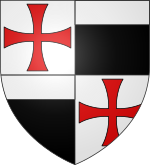Philip of Milly facts for kids
Quick facts for kids
Philip of Milly
|
|
|---|---|

Coat of arms of Philip of Milly
|
|
| 7th Grand Master of the Knights Templar | |
| In office 1169–1171 |
|
| Preceded by | Bertrand de Blanchefort |
| Succeeded by | Odo de St Amand |
| Personal details | |
| Born | c. 1120 |
| Died | 3 April 1171 |
| Nationality | French |
| Military service | |
| Branch/service | |
| Years of service | 1166–1171 |
| Battles/wars | Siege of Ascalon Crusader invasion of Egypt |
Philip of Milly, also known as Philip of Nablus, was an important leader in the Kingdom of Jerusalem. He was born around 1120 and passed away on April 3, 1171. Philip was a powerful noble, called a "baron," and later became the seventh Grand Master of the Knights Templar. This was a very important position in a famous group of warrior monks.
Contents
Early Life and Family
Philip was the son of Guy of Milly, a knight from France. His father owned lands around Nablus and Jerusalem. Philip's mother, Stephanie, was a noblewoman from Flanders. Some old writings say Philip was the oldest son, but his brother Guy was called "Francigena," meaning "born in France." This might mean Guy was born before their parents came to the Holy Land.
Philip inherited his father's lands near Nablus. He married a noblewoman named Isabella before 1144. Not much is known about her, but some historians believe she was related to another important person, Pagan the Butler. Philip first appeared in official records in 1138.
Becoming a Royal Leader
Philip's career really took off after King Fulk died. His wife, Queen Melisende, then became the main ruler of Jerusalem. In 1144, Philip was first mentioned as the lord of Nablus. This meant he was in charge of that area.
Fighting for Edessa
Later in 1144, Queen Melisende asked Philip to lead an army to help the city of Edessa. However, a powerful leader named Imad ad-Din Zengi captured the city before Philip's army could reach it.
Helping the Kingdom Grow
Over the next few years, Philip gained more lands, including areas near Nablus and Tyre. In 1148, when the Second Crusade arrived, Philip joined a big meeting in Acre. At this meeting, a decision was made to attack Damascus, which unfortunately did not go well.
Philip was a strong supporter of Queen Melisende when she had disagreements with her son, Baldwin III. When the kingdom was divided in 1151, Melisende got control of the southern part, which included Nablus. Even so, Philip helped Baldwin during the siege of Ascalon in 1153. He also gave land to the Order of Saint Lazarus in 1153. From 1155, Philip was often listed as a witness on King Baldwin's official papers. He also helped in a battle to protect Banyas in 1157.
Lord of Oultrejordain
On July 31, 1161, Philip traded his lordship of Nablus with King Baldwin III for a region called Oultrejordain. This was a large area east of the Jordan River. Since Queen Melisende was very ill, her sister, Hodierna, confirmed the agreement for her. The king still kept the money from taxes on trade caravans and Bedouin tribes crossing Oultrejordain. Philip made Kerak Castle stronger by adding a ditch and towers. He also went on a religious trip to Saint Catherine's Monastery in the early 1160s.
Joining the Knights Templar
In January 1166, Philip joined the Knights Templar, a famous military order. He gave them a large part of his lands in Oultrejordain, including the castle of Ahamant.
Leading the Templars
Philip went against the Templars' decision and joined King Amalric's invasion of Egypt in 1167. During the siege of Bilbeis, Philip bravely saved the life of Hugh of Ibelin, who had broken his leg. The Templars as a group did not want to support Amalric's invasion. After their Grand Master, Bertrand de Blanchefort, died in January 1169, King Amalric pushed for Philip to be elected as the new Grand Master in August of that year.
With Philip as their leader, the Templars again supported Amalric's invasion of Egypt. However, by the end of the year, Amalric had to retreat. For reasons that are not clear, Philip resigned as Grand Master in 1171. Odo de St Amand took his place. Philip then went with King Amalric to Constantinople as an ambassador to the Byzantine Empire. Their goal was to improve relations after the failed invasion of Egypt. Philip likely died on April 3, 1171, before reaching Constantinople.
Philip's Family
Philip's personal life is mostly a mystery. A historian named William of Tyre described him as a "brave man, skilled in fighting from a young age." Philip had a son named Rainier, who passed away before him, and two daughters, Helena and Stephanie. His wife, Isabella, probably died in 1166. This might have been why Philip decided to join the Knights Templar. His lands were inherited by his older daughter, Helena, and later by Stephanie and her husbands.
Sources
- Setton, Kenneth M., general ed. (1969) A History of the Crusades. 6 vols. Madison, Wis.: University of Wisconsin Press, 1969–1989
- Kenneth M. Setton, general editor (1969) A History of the Crusades. Vol.1: The first hundred years; edited by Marshall W. Baldwin. Madison, Wis.: University of Wisconsin Press
| Religious titles | ||
|---|---|---|
| Preceded by Bertrand de Blanchefort |
Grand Master of the Knights Templar 1169–1171 |
Succeeded by Odo de St Amand |

